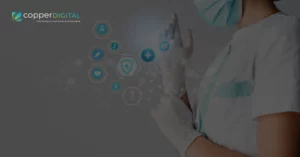A remarkable transformation in the evolving healthcare landscape is unfolding as technology and medicine converge to reshape patient care. At the forefront of this revolution are wearable healthcare devices enhanced by the Internet of Things (IoT) capabilities. These unassuming yet potent gadgets, including smartwatches and pendants, quietly redefine healthcare dynamics.
Gone are the days of healthcare being confined to hospitals and clinics. Wearable IoT devices are breaking down these barriers, enabling individuals to connect closely with their health. Wirelessly, these devices continuously monitor and transmit crucial information such as heart rate, physical activity, sleep patterns, and vital signs to healthcare providers, offering insights beyond intermittent medical visits.
However, these wearables transcend mere data collection. They function as intelligent detectives, deciphering the significance of the data they gather. For instance, in the case of diabetes, these gadgets can promptly alert users to abnormal blood sugar levels, fostering a proactive approach that prevents problems from escalating.
Equally fascinating is how wearable IoT gadgets are transforming the doctor-patient dynamic. By sending real-time data, these devices empower doctors to gain a comprehensive view of patient’s health, facilitating informed treatment decisions. It’s akin to having a knowledgeable health partner by your side, enhancing healthcare outcomes for all.
In this blog, we delve into how wearable health technology revolutionizes patient care. We’ll explore impactful stories, such as how these gadgets have averted heart issues through vigilant monitoring or assisted older adults with fall alerts for increased safety. Additionally, we’ll address crucial concerns, such as ensuring data security and privacy in the convergence of technology and healthcare.
Now, let’s explore the tangible impact of wearable IoT devices as they redefine patient care globally.
Also, Read – The Transformative Power of Machine Learning in Healthcare
Understanding Wearable Technology and IoT in Healthcare
Wearable health technology and Internet of Things (IoT) devices have been transforming patient care in various ways. These devices, often worn on the body or integrated into clothing and accessories, are designed to collect and transmit real-time data about an individual’s health and activities. This data can be used by healthcare professionals, patients, and caregivers to monitor health conditions, make informed decisions, and improve overall well-being. Here are some ways in which wearable health tech and IoT devices are changing the landscape of patient care:

Remote Monitoring and Management
Wearable sensors can continuously monitor vital signs such as heart rate, blood pressure, and blood glucose levels. This data can be sent to healthcare providers remotely, allowing them to track patients’ health status without requiring frequent in-person visits. This is particularly valuable for individuals with chronic conditions who need regular monitoring.
Early Detection and Prevention
Wearable health devices can help detect early signs of health issues. For instance, certain wearables can monitor sleep patterns and activity levels to identify changes that might indicate the onset of conditions like sleep apnea or cardiovascular problems. Timely detection allows for early intervention and prevention.
Personalized Healthcare
Wearable devices generate a wealth of personalized data, which can tailor healthcare plans to an individual’s needs. This can lead to more effective treatment strategies and better health outcomes.
Medication Adherence
Some wearables are designed to remind patients to take their medications at the right times. These devices can send alerts or notifications, helping individuals stick to their treatment regimens and improve medication adherence.
Chronic Disease Management
Patients with chronic diseases like diabetes, asthma, or hypertension can benefit from wearable devices that track relevant metrics. These devices can provide insights into how lifestyle factors impact their conditions, empowering them to make healthier choices and manage their needs more effectively.
Post-Operative Monitoring
Wearable devices can remotely track patients’ recovers after surgeries or medical procedures. Doctors can monitor healing, spot potential complications, and adjust treatment plans as needed without requiring patients to stay in the hospital.
Data-Driven Decision Making
Wearable health tech generates vast data that can be analyzed to gain insights into health trends and patterns. Healthcare professionals can use this data to make informed treatment plans and intervention decisions.
Wellness and Lifestyle Improvement
Wearables are not just for medical conditions; they can also encourage healthy behaviors and lifestyle changes. Fitness trackers and smartwatches can motivate individuals to exercise, maintain healthy activity levels, and manage stress.
Senior Care
IoT devices and wearables are also being used to enhance the care of older adults. Fall detection, location tracking, and health monitoring can help caregivers keep a closer eye on their loved ones’ well-being and safety.
Clinical Trials and Research
Wearable devices are becoming increasingly important in clinical trials and medical research. They allow researchers to gather objective, real-world data from participants, leading to more accurate results and insights.
However, it’s important to note that while wearable health tech and IoT devices hold great promise, there are also challenges to address. Privacy and data security concerns, data collection accuracy, regulatory compliance, and integration with existing healthcare systems are some of the issues that need to be carefully managed as this technology continues to evolve. Let’s quickly understand the critical challenges of wearable technology and IoT in healthcare.
Navigating Challenges in Wearable Technology and IoT Devices
As read above, wearable health tech and Internet of Things (IoT) devices have emerged as promising tools that can significantly impact the healthcare industry and improve people’s lives. These devices encompass various products, including smartwatches, fitness trackers, smart clothing, and other sensor-equipped wearables that can monitor different health metrics and collect valuable data.
Despite their potential benefits, several significant challenges must be addressed to ensure the responsible and effective integration of wearable health tech and IoT devices into the healthcare landscape. Such as:

Privacy and Data Security Concerns
Wearable health tech and IoT devices often collect sensitive personal health data. This information can include heart rate, sleep patterns, activity levels, and even more complex medical data. As such, ensuring robust privacy and data security measures is crucial to protect user’s sensitive information from unauthorized access, breaches, and misuse.
Accuracy of Data Collected
The reliability and accuracy of the data collected by wearable health tech and IoT devices are paramount. Inaccurate data could lead to incorrect diagnoses, improper treatments, and potential health risks. Manufacturers and developers must continually improve the precision and validity of the data captured by these devices.
Regulatory Compliance
The healthcare industry is highly regulated, and wearable health tech and IoT devices are no exception. Manufacturers and developers must comply with various regional and international regulations, including data protection, medical device certifications, and adherence to healthcare standards. Meeting these requirements can be challenging, especially as technology evolves rapidly.
Integration with Existing Healthcare Systems
To be truly effective, wearable health tech and IoT devices must seamlessly integrate with existing healthcare systems and electronic health records (EHRs). Interoperability between different devices and healthcare software is vital to enable healthcare providers to access and interpret the data efficiently.
User Adoption and Engagement
Encouraging widespread adoption and sustained use of wearable health tech and IoT devices can be challenging. People may initially embrace the technology but lose interest or struggle to interpret the data over time. Engaging users through user-friendly interfaces, personalized insights, and effective feedback mechanisms can help address this issue.
Data Overload and Management
The continuous data stream generated by wearable health tech and IoT devices can lead to data overload for users and healthcare providers. Implementing effective data management strategies, including filtering, aggregation, and analysis, is essential to extract meaningful insights without overwhelming users or healthcare professionals.
Ethical Considerations
As wearable health tech and IoT devices become more prevalent, ethical questions surrounding data ownership, consent, and potential discrimination based on health data may arise. Striking a balance between data-driven healthcare advancements and respecting individual rights and autonomy is crucial.
Health Inequality
Access to wearable health tech and IoT devices is not uniform across populations, which may exacerbate health inequalities. It’s essential to ensure these technologies are accessible and affordable to everyone, regardless of socio-economic status.
Also, Read – How to Build an App To Enhance Emergency Healthcare Services
Future Trends of Wearables and IoT in Healthcare
Advanced Diagnostics and Monitoring
Wearables will evolve to detect a broader range of health conditions precisely. From monitoring stress levels to assessing respiratory health, these devices will become integral tools for early detection and continuous monitoring.
AI-driven Insights
Artificial Intelligence will be harnessed to derive deeper insights from the data generated by wearables. Machine learning algorithms will predict health issues and provide personalized recommendations for healthier lifestyles.
Telemedicine Integration
Wearables will seamlessly integrate with telemedicine platforms, allowing healthcare providers to remotely assess patients’ health in real-time and adjust treatment plans accordingly.
Smart Implants and Sensors
Implantable devices will become more competent and versatile, offering long-term tracking and treatment delivery for chronic conditions, further erasing the line between medical intervention and daily life.
Wearables for Mental Health
The focus will expand to mental health, with wearables capable of monitoring stress levels, sleep quality, and emotional well-being, facilitating early interventions, and destigmatizing mental health care.
Healthcare Ecosystem Connectivity
Wearables and IoT devices will become key players in the interconnected healthcare ecosystem, collaborating with electronic health records, medical devices, and other data sources to provide a comprehensive view of patients’ health.
Regulatory Evolution
Regulatory bodies will adapt to accommodate the rapid evolution of wearable health tech and IoT devices, providing more straightforward guidelines to ensure innovation and patient safety.
Personalized Treatment Plans
Wearables enable healthcare professionals to create highly customized treatment plans based on real-time data, leading to more effective interventions and improved outcomes.
In the End!
The era of hospital-centric care is giving way to continuous and interconnected health management facilitated by wearable IoT devices. These devices harmonize a wealth of data, consistently tracking vital metrics, physical activity, and sleep patterns while establishing a direct connection to healthcare providers. This seamless link dismantles the limitations of sporadic medical consultations, ushering in an epoch of perceptive, all-encompassing care across an individual’s life.
Beyond mere data aggregators, these intelligent wearables act as vigilant health associates adept at deciphering gathered data’s implications. They anticipate impending health challenges, like diabetes-related fluctuations in blood glucose, enabling swift interventions to avert escalation. The collaboration between medical professionals and patients evolves into a dynamic partnership fueled by real-time data, enhancing treatment decisions and deepening comprehension of personal health narratives.
The convergence of wearable health technology and IoT devices unveils vast potential to transform patient care. As we embrace this era, we must address challenges accompanying these shifts, including data privacy, accuracy, regulatory compliance, user engagement, and accessibility, all integral for fully harnessing wearable technology and healthcare software solutions‘ capabilities.
In conclusion, integrating wearable technology and IoT devices enables a patient care era characterized by personalization and proactivity. These innovations enhance healthcare outcomes and reshape healthcare delivery and experience. Embracing these transformative technologies, we stand at the edge of a healthier, more interconnected future for individuals worldwide.




